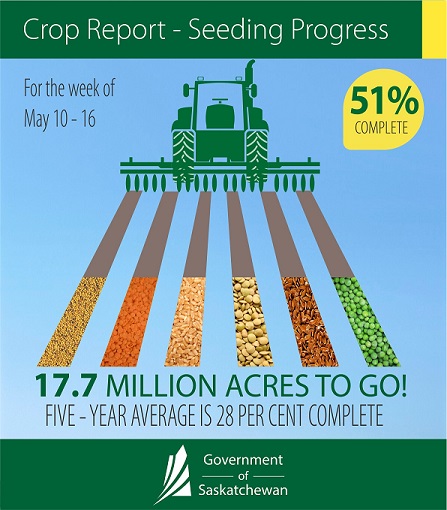Released on May 19, 2016
Despite a cool and wet start to the week, seeding is advancing at a remarkable rate, according to Saskatchewan Agriculture’s Weekly Crop Report. Fifty-one per cent of the crop is now seeded, well ahead of the five-year (2011-2015) average of 28 per cent for this time of year.
Some producers have wrapped up seeding operations, while others will need another couple of weeks of warm and dry weather.
Seeding is most advanced in the southwest, where producers have 70 per cent of the crop in the ground. Sixty per cent of the crop is seeded in the southeast; 56 per cent in the northwest; 53 per cent in the west-central region; 30 per cent in the east-central region; and 29 per cent in the northeast.
Eighty-four per cent of field peas, 80 per cent of lentils, 78 per cent of chickpeas, 63 per cent of durum, 57 per cent of mustard, 51 per cent of spring wheat and 39 per cent of canola have now been seeded.
Topsoil moisture conditions have greatly improved in many regions thanks to the recent rain. However, some areas in the province will still need rain in the coming weeks to help crops germinate and emerge. Cropland topsoil moisture is rated as six per cent surplus, 77 per cent adequate, 13 per cent short and four per cent very short. Hay land and pasture topsoil moisture is rated as three per cent surplus, 71 per cent adequate, 21 per cent short and five per cent very short.
The majority of the province received rain last week, ranging from trace amounts to nearly 100 mm. Frost struck some areas last week, although damage appears to be minimal as most vulnerable crops have not yet emerged.
Producers are busy seeding and controlling weeds.
Follow the 2016 Crop Report on Twitter at @SKAgriculture.
-30-
For more information, contact:
Shannon Friesen
Agriculture
Moose Jaw
Phone: 306-694-3592
Email: shannon.friesen@gov.sk.ca

